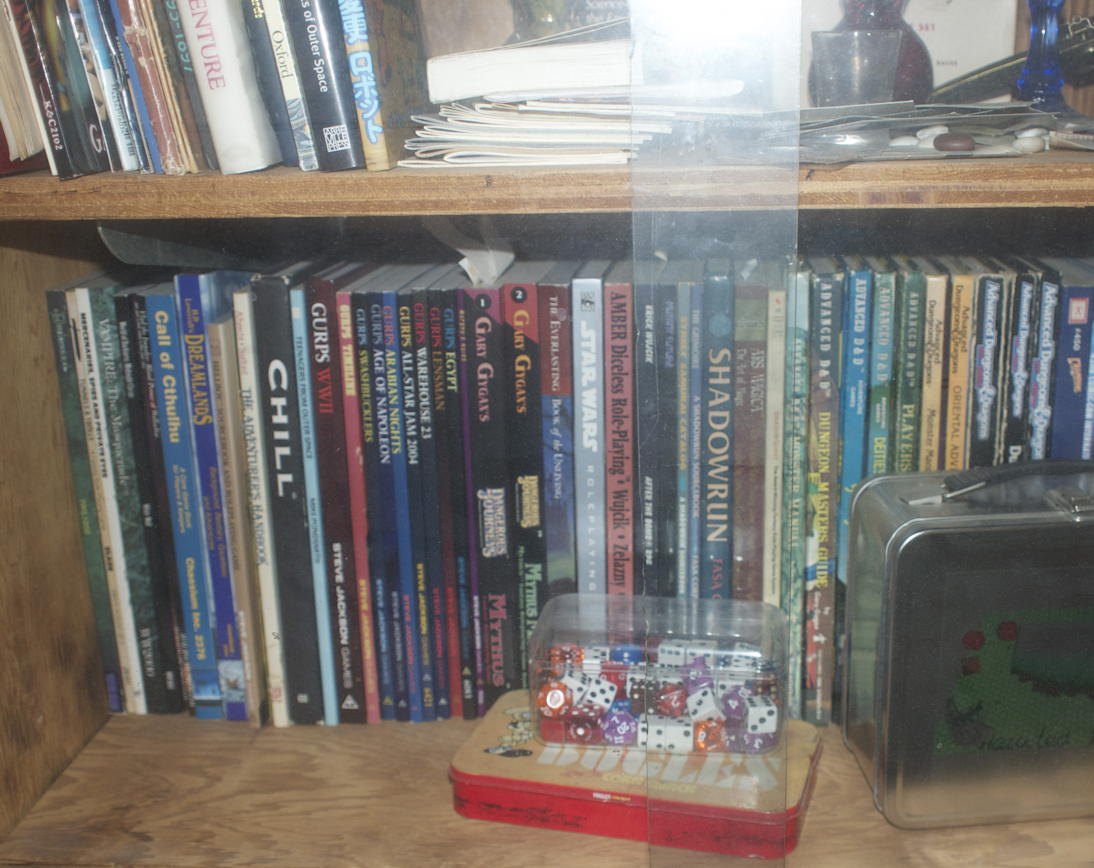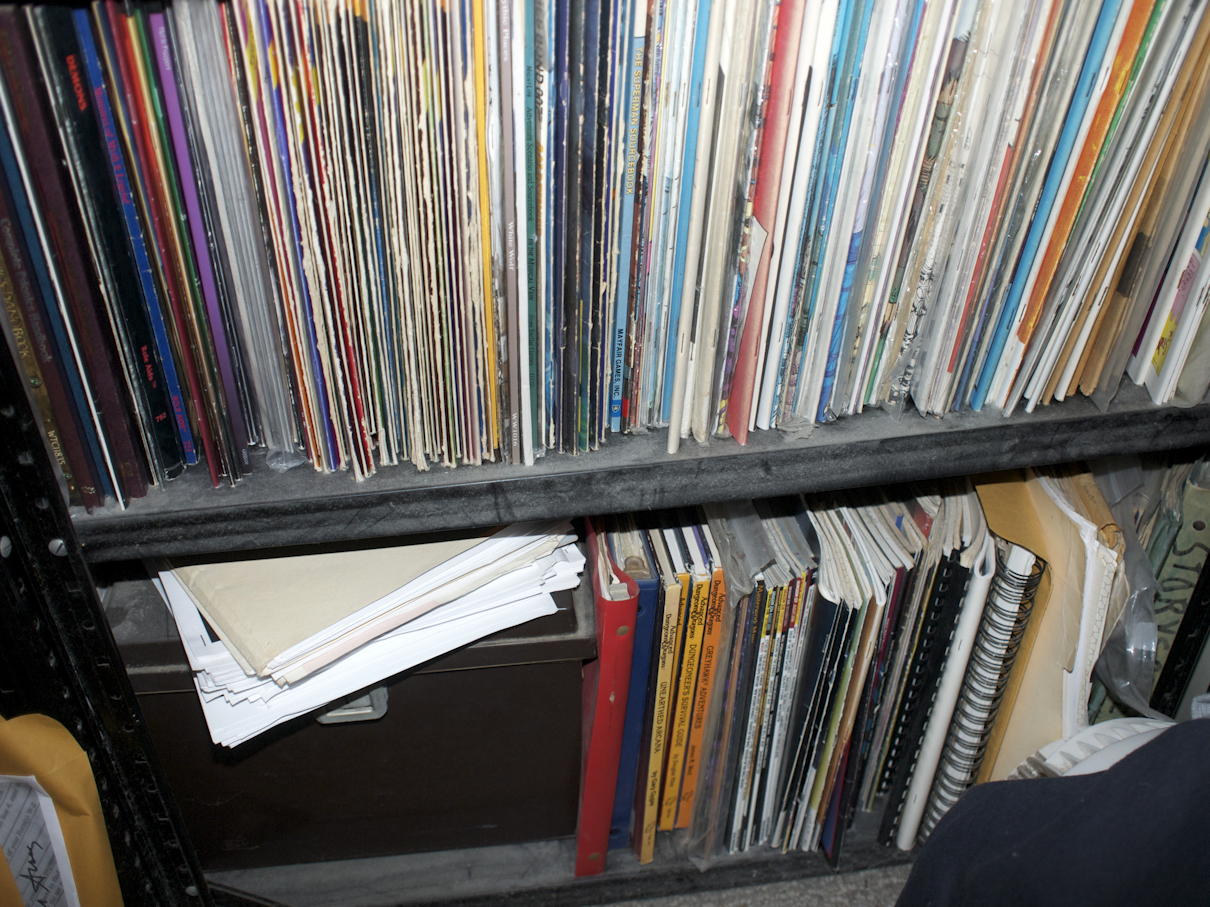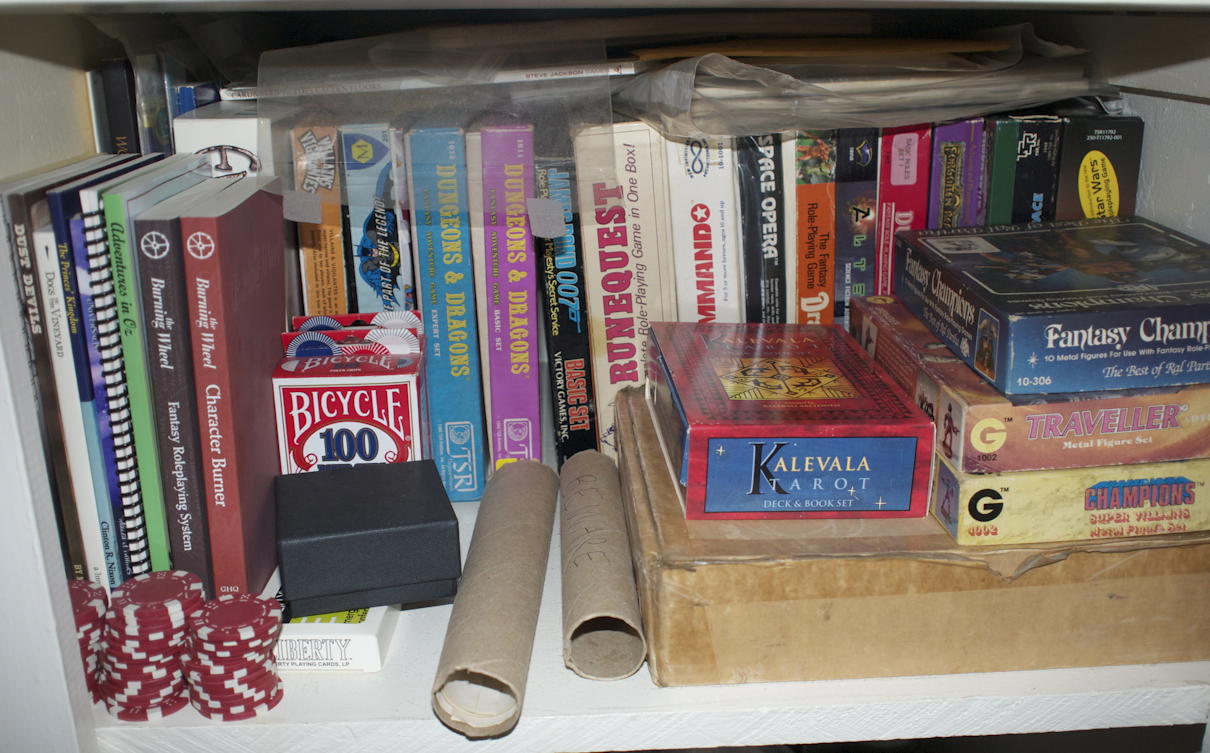Game Junky
…once you get locked into a serious drug collection, the tendency is to push it as far as you can. — Hunter S. Thompson (Fear and Loathing in Las Vegas)
James Maliszewski wants to see our junk, and we are obliging. I ran across the “My Gaming Shelves” blogstorm on the Greyhawk Grognard and Bat in the Attic (two great blogs you ought to be following); realized I’ve always enjoyed looking at other people’s game shelves, and so I have joined the meme.
I live in a small apartment. I don’t have one gaming shelf, I have several scattered in corners where I can find space. Some of them are out front to show them off, some are by my computer for inspiration, and some are wherever I can find space.
This shelf is in the front room. The big requirement for these games is that they have a spine, and that they’re interesting—they tend to be conversation starters. You can see a lot of first edition and second edition AD&D here. When second edition came out it made me hopeful for the future of the game. When we just had those first two rulebooks, it looked like AD&D was moving to a simplification of arcane rules, and a consolidation of contradictory and redundant rules. While second edition had its flaws, my hope, when I read it, was that AD&D could merge with D&D and provide the simplicity and ease of play of D&D with the variety of AD&D. Playing second edition was a little like playing on the hope of future games.
What we got instead was D&D merging into the complexity of AD&D, taking its naked incomprehensibility to a new degree. Nowadays, if we play AD&D, we play first edition. But it was second edition’s apparent direction that got me thinking about the house rules that eventually blossomed into Gods & Monsters.
Except for AD&D we don’t play any of these games any more; if we continue to game after Gods & Monsters I’m hoping for Villains & Vigilantes, which, since it has very little spine, is in the office/bedroom.
You can also see two seminal boxed sets if you look closely at the top shelf. I have the reprint White Box and the Traveller Black Box. Traveller I picked up in my recent eBay spree, but the OD&D books I managed to get in the nineties before prices skyrocketed, except for Swords & Spells which I picked up in the eighties at college. I remember seeing an Eldritch Wizardry back then, too, and wishing I could pick it up, but at $12 it was beyond my limited budget! Fortunately I found a decent copy around the same time I got the White Box—along with the rest of the LBBs.
A lot of the games I buy I’ve never played, but most of the ones I have played are on this shelf: we went through a Shadowrun/Vampire phase shortly after I moved to San Diego in the early nineties. We were all pulling part-time jobs and still had time (and also in many cases sharing houses/apartments, which helped in putting together quick pickup games). We lost track of both of those games about the time their second editions came out.
I don’t think we’ve ever finished a Call of Cthulhu game, which is odd, because it’s easily the most finishable game on the shelf.
The oldest books on this shelf are the first edition AD&D books. The Players Handbook is the very first book I bought with my own money, and the rest followed fairly quickly. They are also by far the most-used books; it’s amazing how well they’ve held up over the years. I have hardcovers and softcovers that are a decade or more younger that are more beaten up. Our long-time AD&D GM tells a story about using the Dungeon Masters Guide under the tire of his pickup to get out of a snowbank. That book was definitely ragged, but it was still usable.
Also on the top shelf you can see a copy of Sorceror, the World of Greyhawk, and the Hackmaster GM shield. Sorceror has its slipcover removed, because it looks cooler as a sorcerous tome without it. I’ve owned World of Greyhawk since the eighties; and the Hackmaster GM shield is hilarious. It’s what finally convinced me to stop using GM shields.
Tomorrow: what’s in the closet?
- December 2, 2012: Final Game Junky: The Spineless
-
For a few years in the middle of the last decade (when the economy was doing better) I started haunting eBay, Noble Knight, and other sources of used role-playing games, filling out the adventures and other supplements I’d missed back in the eighties.
Over on the lower right are the Dragon Magazines I own that are not on the Dragon CD-ROM archive; the rest are in a box in the closet, except for three that have articles by me, and they’re somewhere in the front room, probably covered in dust since I don’t remember exactly where they are. To the right of the greater-than-250 Dragons are spiral-bound copies of the Neo-Anarchists Guide to Everything Else, the Shadowrun webzine I published before there was a web to speak of. I distributed it on Usenet and my FTP/Gopher site—the original Cerebus the Gopher. To the right of that are some old maps and notes from old campaigns—mostly, I think, ones I’ve played in rather than run.
To the left of the newer Dragons are all of the Dungeon magazines I own; there aren’t very many. For some reason I liked the adventures from Dragon better than the ones in Dungeon that succeeded them.
To the left of the Dungeon magazines is one of my real prizes. Back in college in Ithaca in the eighties, my friends and I walked into the local game store and I found a zip-loc bag with a photocopied black-and-white Creeks & Crawdads. It is by far the funniest game I’ve ever read, deliberately so. It made fun of most game fads up to the time it was printed, from Dungeons & Dragons to the post-apocalyptic games that were cropping up.
Then there are the AD&D first edition supplemental books, Unearthed Arcana (perhaps the biggest reason I thought second edition AD&D was a step in the right direction), the two survival guides, and Greyhawk Adventures. We never used Greyhawk; except for a brief love affair with the Realms toward the end of our college career we mostly just gamed in worlds made up for that game, with as little made up as possible. Unearthed Arcana was one of those things we used because it was official but we constantly made fun of. Except for UA I picked up all four of these books in the last couple of years.
- December 1, 2012: Game Junky III: The Office
-
Most of my gaming magazines are below the spineless shelf but I keep a few one-offs or close to it here. Silver, Swords & Sorcery was a zine from the days of Usenet that I helped support by buying advertising for Men & Supermen. It was originally Silver, Swords & Slaughter but the publisher changed the name to appeal to a wider audience. As far as I know it never got past the issue 5 that you see here.
Push was a neat little one-off in a similar vein to Interactive Fantasy. It has articles by John H. Kim and Emily Care Boss, among others. There was only ever one issue, which is too bad. I think it was originally meant to be an annual. Interactive Fantasy suffered a similar fate but after four issues. This was a fascinating quarterly journal of gaming scholarship that included articles by scholars as well as design notes by designers. The fourth and final issue had Everway designer’s notes from Jonathan Tweet and musings on self-censorship from Lee Gold. As you can see here it also had some very nice covers by some great artists. The multi-colored weird one on the bottom was Mary Fleener, for example. IF was a neat effort by Andrew Rilstone of Hogshead, it’s too bad it couldn’t last.
Off to the left are a couple of reference books. I owned the James Bond Thrilling Locations book long before I owned the James Bond game it was written for. It’s very well written and a useful resource for any game that takes place in the semi-real world. Underneath that is the James Bond RPG Q Manual and Weapons & Castles from Palladium. Both provide great ideas for neat toys. Next to that is Jason Morningstar’s Story Games Names Project book. Not sure why this was on the shelf, I usually try to keep it in the briefcase. It’s a collection of names from many cultures. Need an Aztec name? A Roman name? A Maori name? A cowboy name? It’s got a chapter for each, and much more. Very useful for making a new character in a world-spanning game, but indispensable when coming up with names for NPCs, which is probably why it’s on the shelf and not in the briefcase.
- November 30, 2012: Game Junky II: The Hall Closet
-
The box sets are in the hall closet. This is where my gaming life started. First, the purple-book D&D Basic, which remains the gold standard of D&D writing for my taste. Then, in college, we added Runequest and DragonQuest to our special game nights (AD&D was always first). This is the same DragonQuest that we played then. I found it in the local off-campus textbook store in a box of discount items. Our entire group went back to that box and everyone picked it up. This is not the same Moldvay purple box, however. In high school I cut my D&D Basic and Expert books apart and put them into a binder, and then gave that binder away to my youngest brother when I left for college. It’s been long since thrown out, which is too bad because it was filled with notes as well. I picked these up on eBay out of nostalgia.
Back then, we also used miniatures, mainly just to show marching order and so that the DM would know who was affected by traps. All of these miniature sets are from the eighties; we occasionally consider using miniatures again but it takes away room for food, and food is more important now that it’s no longer Fritos and M&Ms. That big brown box underneath the Champions miniatures is also a box of miniatures; I picked it up at a yard sale and have no idea of the provenance of most of the figurines in it.
We don’t use miniatures, but we do still use props. Those two paper towel rolls contain ancient scrolls and maps—printed on laser printer and aged with Trader Joe’s tea. The Kalevala tarot is our version of the Deck of Many Things. It appears in Red Jack’s Gambling House in Helter Skelter.
In a lost alley there is a door behind a door and within it a deck of cards and fortune’s wheel. Upon the deck are forgotten gods; upon the wheel the world rests.
Using a tarot deck with the gods of the Kalevala for “forgotten gods” was a nice touch, and purely random: I picked up the deck because it was only $5.00 at Borders and it looked cool. I used it for Red Jack because it was, in fact, cool and because I had it on hand.
Despite what it looks like here, I’m not a big buyer of box sets. I picked Everway up from Adventure Retail at the San Diego Comic-Con many years ago from a huge pile for $5.00. Cyborg Commando came from a dollar store for—a dollar. This dollar store was on the corner around the block from my apartment at the time; this find made me go in there much more often afterward, but no new games showed up. Cyborg Commando is interesting in that it uses a similar system to Gygax’s later Dangerous Journeys.
- Starting a Meme: James Maliszewski at Grognardia
- “Posted above is a photo of the shelf immediately above my desk, where I do most of my writing. The books on that shelf are the ones to which I refer most often, both in my writing and in my playing. What I'd love to see are more photos like this, with people showing off the shelves to which they most frequently turn in their writing and (especially) gaming.”
- My Gaming Shelves: Rob Conley at Bat in the Attic
- “From top to bottom D&D 4e, GURPS Traveller/Mongoose Traveller/GURPS Stuff, and the bottom two all my GURPS books.”
- My Gaming Shelves: Joseph Bloch at Greyhawk Grognard
- “Never one to let a good bandwagon go by unjumped-upon, here's what I look at every day as I sit at my computer. Not my complete gaming collection by a long shot, but that's where my eyes light when I sit at the desk waiting for inspiration.”





“We had two editions of AD&D, 65 Judges Guild modules, five volumes of the Best of Dragon, a box set with half of Greyhawk, a whole galaxy of multi-colored dice, miniatures, grids, maps… Also, a bag of M&Ms, a can of Pringles, a case of Jolt, the original Vampire: The Gathering, and two dozen kobold figurines. Not that we needed all that for the adventure, but once you get locked into a serious game collection, the tendency is to push it as far as you can. The only thing that really worried me was Vampire. There is nothing in the world more helpless and irresponsible and depraved than a man in the depths of a Vampire binge, and I knew we’d get into that rotten game pretty soon.”